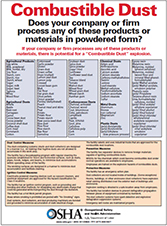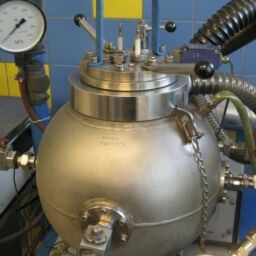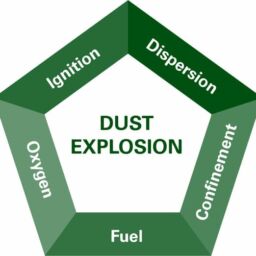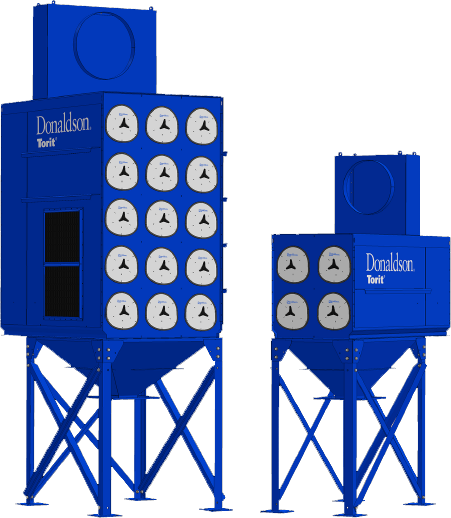Dust Collectors and Combustible Dust Strategies
Understanding the basics
Combustible dust is present in a variety of different process industries including:
Food and Beverage
Wood and Biomass
Chemical
Pharmaceutical
Coal
Plastics
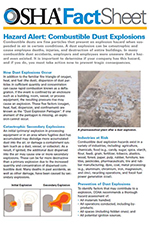
Some of the common problems OSHA sees include:
- Missing or ineffective dust control leading to housekeeping issues
- Dust collectors indoors, rather than outside as OSHA expects to see if the collectors filter combustible dusts
- No isolation on inlets and/or outlets to prevent the propagation of an deflagration to other process equipment
- Explosion vents
- Dust collectors with no vents that are filtering combustible dusts
- Dust collectors with vents that are venting to an unsafe area
Many process requirements make elimination of combustible dust, mist, or fume impractical. However, it may still be very possible to manage the dispersion of dust within your plant by using an appropriate and effective industrial ventilation system including dust collection. A well designed, maintained, and operated industrial ventilation system including good hoods, proper duct sizes, and properly selected collection equipment can provide effective dust control and can therefore help manage the presence of dispersed dust. This not only reduces housekeeping frequency and expense, but also may help you reduce the risk of dust explosions in your facility, particularly the destructive secondary explosions, by helping reduce the presence of dispersed fuel in your facility.
Dust Explosions are unique and complex phenomena that are as unpredictable as they are dangerous. Although no two dust explosions are ever the same, the five elements listed in the “Dust Explosion Pentagon” must all be present in order to initiate one of these destructive events.
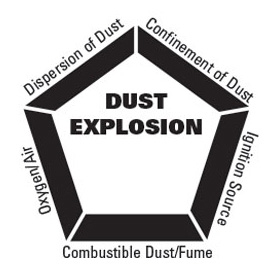
2) Dispersion of Dust: The explosive dust being processed must be entrained in a cloud of sufficient concentration.
3) Confined Area: An enclosed structure surrounding the suspended dust cloud must exist in order to achieve the pressure rise characteristic of a dust explosion. In the absence of a confined area, flash fires are still a hazard but explosions typically are not.
4) Oxygen: O2 in optimum concentration must be the medium for handling the explosive dust.
5) Ignition Source: When all other elements are present, an ignition source is the last piece of the puzzle needed to activate the dust explosion chemical reaction. Often the most elusive of the five elements, ignition sources can be generated in a multitude of applications and come in a variety of forms. Some examples include smoldering or burning dust, open flames, hot surfaces, heat from mechanical impact and electrical discharges.
Combustible dust remains a widely discussed topic and management of dust using filtration technology will have a role in many risk management strategies. To see how dust collectors can work help with your combustible dust risk management strategy, contact us at [email protected] today.
Overview of Codes and Standards
On October 18, 2007 the United States Occupational Safety and Health Administration (OSHA) released a directive initiating a National Emphasis Program (NEP) to address the hazards associated with combustible dusts. In the wake of a large explosion at a sugar refining facility OSHA reissued a revised Combustible Dust National Emphasis Program on March 3, 2008.
Currently OSHA does not have a specific standard to address combustible dust hazards. However, the National Fire Protection Agency (NFPA) has several standards that address these hazards. The responsibility of compliance with applicable standards falls upon the owner / operator of facilities handling combustible dusts. Several NFPA “keyway” standards exist depending on the type of facility you operate. Some facilities may require compliance with more than one standard:
NFPA 61 Standard for the Prevention of Fires and Dust Explosions in Agricultural and Food Processing Facilities
NFPA 484 Standard for Combustible Metals
NFPA 652 Standard on Combustible Dust
NFPA 654 Standard for the Prevention of Fire and Dust Explosions from the Manufacturing, Processing, and Handling of Combustible Particulate Solids
NFPA 655 Standard for Prevention of Sulfur Fires and Explosions
In addition to the “keyway” standards, several “how to” standards exist to assist owner/operators to meet compliance with the “keyway” standard that governs their process or facility:
NFPA 68 Standard on Explosion Protection by Deflagration Venting
NFPA 69 Standard on Explosion Prevention Systems
NFPA 499 Recommended Practice for the Classification of Combustible Dusts and of Hazardous (Classified) Locations for Electrical
Additional codes have been developed by FM Global based on property loss data sheets.
For additional information regarding the National Fire Protection Agency please visit www.nfpa.org
For additional information regarding the United States Occupational Safety & Health Administration visit www.osha.gov
For additional information regarding FM Global Property Loss Data Sheets visit www.fmglobal.com/fmglobalregistration/
Dust Collection Systems tailored to your operations
Dust collectors are an indispensable component of many plants’ combustible dust compliance strategies. Your collector choice may influence your combustible dust mitigation strategy and the location of your collector may help reduce the costs of explosion risk mitigation.
There are many types of devices and systems used to comply with NFPA standards for the explosion protection of dust collection systems. As a process owner, you are responsible for the selection of your combustible material management strategy and to assure compliance with all applicable federal, state, and local codes and standards.
Is your plant effectively managing the risks associated with combustible dust in its processes?
It is vital for plant leaders to understand the risks of combustible dust and ensure they manage combustible dusts in their facilities. Dust collector representatives can help to support your combustible dust control strategy by interfacing with you and your experts on fire and explosion protection equipment and solutions. To see how dust collectors can work help with your combustible dust risk management strategy, visit with your local dust collector representative or send us an email at [email protected].


